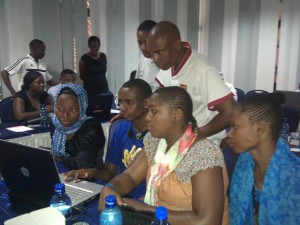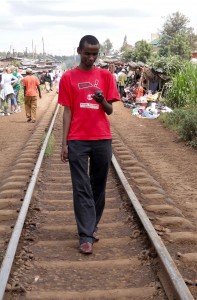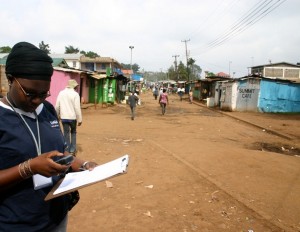The Map Kibera team had a busy end to 2011. From August to the end of December 2011, we have been involved in projects in Kibera, Mukuru (Nairobi), Kwale (Coast) and Dar es Salaam (Tanzania). Mappers from Kibera have travelling across the city, country and even regionally to share their skills with other young people in East Africa. They trained approximately 40 young people in Mukuru, 30 in Kwale and students from Ardhi University in Dar es Salaam. This networking and sharing is beginning to create an informal network of young people, with skills, experience and passion for mapping for change. Although they are not always working in Kibera, the exposure the mappers get also helps to continue to “put Kibera on the map.”

Work on the atlases and wall painting for Kibera is also ongoing. The final edits are underway and 2012 will be busy for the team – producing an atlas distribution strategy, contacting partners for atlas request, visiting schools and health clinics and painting walls! Of course, the team will also gather feedback and document the process to being to better understand how community information can lead to change.
As we move into 2012, the Map Kibera team wishes you a wonderful start to the new year!
On August 16th, Map Kibera Trust posted about the bonus day on Global Giving’s August Open Challenge. We are pleased to announce that in 1 day we raised $990 from 18 donors, and received $82 in matched funding from Global Giving! Thanks to all of you who donated on that day, and throughout the challenge. We are honoured to have your support!
NOW we have 8 days left to raise $1,485 to complete our fundraising goal of $4,000. To date we have raised $2,515 towards our goal (with a bonus of $82 from the bonus day fundraising efforts).
Please share this widely – Map Kibera needs your support to Turn Maps into Action in Kibera!

Zack Wambua maps the railway line in Kibera
Map Kibera Trust put Kibera on the world map! Our team of community mappers plan to bring the map information to local change agents in the community, through printed atlases and map murals throughout Kibera.
To support our work, we are currently participating in the Global Giving August Open Challenge. During the challenge, we have 4 weeks (August 2nd – August 30th) to raise $4,000 from 50 unique donors. To date, Map Kibera has raised $1,685 from 24 amazing supporters. Get involved and help us meet our goal so that we can print maps and paint wall “map murals” to share information in Kibera.
Follow this link to give today! (P.S. Today (August 16th) is Bonus day on the challenge each donation will be matched by an extra 15% by Global Giving!).
Read on below to hear about our project.

What is the issue, problem, or challenge?
Kibera, in Nairobi, Kenya, is a slum housing some 250,000 people. Kibera is likely the most photographed, researched, and well-known slum in the world. Before October 2009 however, Kibera did not appear on the world map. Map Kibera trained thirteen youth from the slum to use GPS devices to map points of interest in their community, such as clinics, water sources, landmarks, toilets, street lights, and businesses. The youth will now reach out the the community and 200 change agents with the maps.
How will this project solve this problem?
The Map Kibera team wants to make sure that the local community is part of discussions about the challenges facing slum residents around the word. This project will reach out to local change agents to distribute the maps and discuss how geographic information and open data can be used to improve project delivery and development in Kibera and other slums around the world.
Potential Long Term Impact
We will reach out to 200 change agents around Kibera to discuss how community generated information can improve the delivery of services and the implementation of projects in Kibera.
Project Message
“The training and the whole process of mapping has changed me…I feel much more confident and well informed…I will not leave Kibera but will stay and make it a better place to live.”
– Regynnah Awino, Kibera mapper
Update: it’s 50 unique donors, rather than 40. Thanks!


